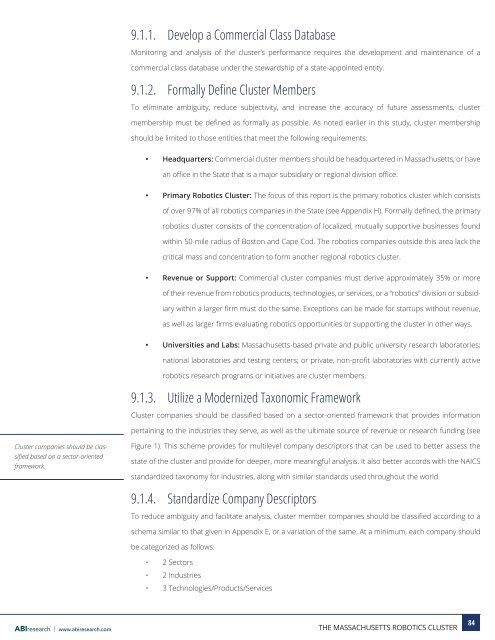ROBOTICS CLUSTER
Massachusetts%20Robotics%20Cluster%20Report%20Final
Massachusetts%20Robotics%20Cluster%20Report%20Final
Create successful ePaper yourself
Turn your PDF publications into a flip-book with our unique Google optimized e-Paper software.
9.1.1. Develop a Commercial Class Database<br />
Monitoring and analysis of the cluster’s performance requires the development and maintenance of a<br />
commercial class database under the stewardship of a state-appointed entity.<br />
9.1.2. Formally Define Cluster Members<br />
To eliminate ambiguity, reduce subjectivity, and increase the accuracy of future assessments, cluster<br />
membership must be defined as formally as possible. As noted earlier in this study, cluster membership<br />
should be limited to those entities that meet the following requirements:<br />
• Headquarters: Commercial cluster members should be headquartered in Massachusetts, or have<br />
an office in the State that is a major subsidiary or regional division office.<br />
• Primary Robotics Cluster: The focus of this report is the primary robotics cluster which consists<br />
of over 97% of all robotics companies in the State (see Appendix H). Formally defined, the primary<br />
robotics cluster consists of the concentration of localized, mutually supportive businesses found<br />
within 50-mile radius of Boston and Cape Cod. The robotics companies outside this area lack the<br />
critical mass and concentration to form another regional robotics cluster.<br />
• Revenue or Support: Commercial cluster companies must derive approximately 35% or more<br />
of their revenue from robotics products, technologies, or services, or a “robotics” division or subsidiary<br />
within a larger firm must do the same. Exceptions can be made for startups without revenue,<br />
as well as larger firms evaluating robotics opportunities or supporting the cluster in other ways.<br />
• Universities and Labs: Massachusetts-based private and public university research laboratories;<br />
national laboratories and testing centers; or private, non-profit laboratories with currently active<br />
robotics research programs or initiatives are cluster members.<br />
9.1.3. Utilize a Modernized Taxonomic Framework<br />
Cluster companies should be classified based on a sector-oriented framework that provides information<br />
pertaining to the industries they serve, as well as the ultimate source of revenue or research funding (see<br />
Cluster companies should be classified<br />
based on a sector-oriented<br />
framework.<br />
Figure 1). This scheme provides for multilevel company descriptors that can be used to better assess the<br />
state of the cluster and provide for deeper, more meaningful analysis. It also better accords with the NAICS<br />
standardized taxonomy for industries, along with similar standards used throughout the world.<br />
9.1.4. Standardize Company Descriptors<br />
To reduce ambiguity and facilitate analysis, cluster member companies should be classified according to a<br />
schema similar to that given in Appendix E, or a variation of the same. At a minimum, each company should<br />
be categorized as follows:<br />
• 2 Sectors<br />
• 2 Industries<br />
• 3 Technologies/Products/Services<br />
www.abiresearch.com<br />
THE MASSACHUSETTS <strong>ROBOTICS</strong> <strong>CLUSTER</strong><br />
84


